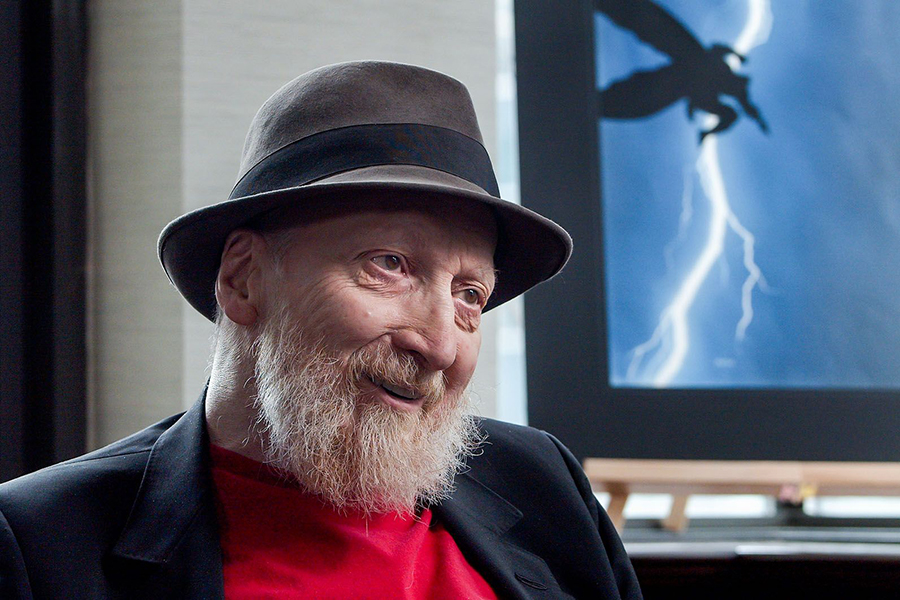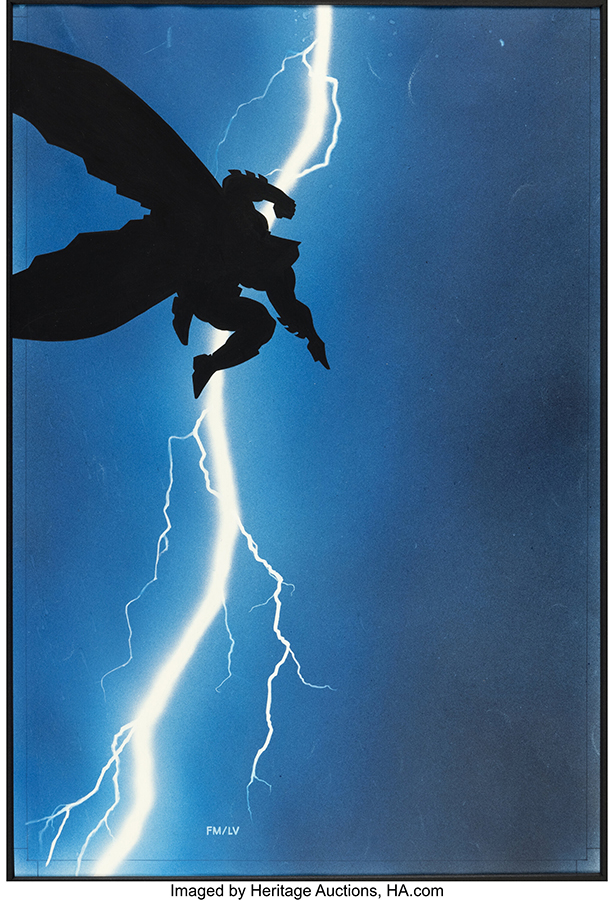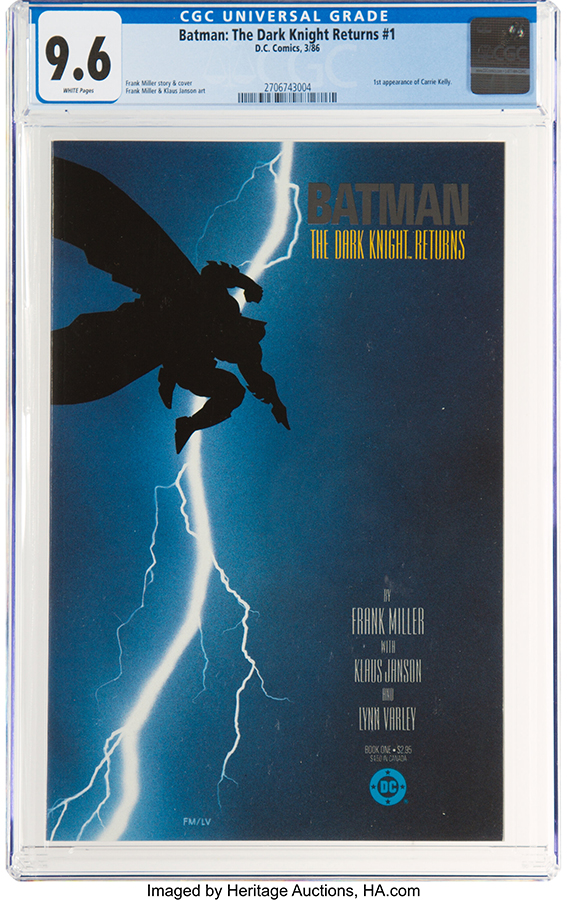STRIKING COVER ART FOR ‘THE DARK KNIGHT RETURNS’ BOOK ONE MAKES ITS AUCTION DEBUT
By Robert Wilonsky
Batman was referred to as “The Dark Knight” in his very first solo comic book, 1940’s Batman No. 1 – in the last panel on Page 11, after The Joker, making his debut, kicks the unconscious hero off a bridge. Wrote his co-creator Bill Finger, “The shock of cold water quickly revives The Dark Knight.”
► EVENT
COMICS & COMIC ART SIGNATURE® AUCTION 7274
June 16-19, 2022
Online: HA.com/7274a
INQUIRIES
Todd Hignite
214.409.1790
ToddH@HA.com
But it was writer-artist Frank Miller who made the nickname stick, who seized upon the appellation by which Batman is perhaps best known to generations of comic-book readers and moviegoers. And it began with the publication of his four-part epic The Dark Knight Returns, the brutal, gritty and darkly droll tale that hit shelves and spinner racks like a bolt of lightning in February 1986 and provided Batman (if not the entire comics industry) with what critic Elvis Mitchell calls “a savage rebirth.”
“What Dark Knight did to superhero comics and the superhero genre itself, it was a big, fat Dope Slap,” Miller says. “It just slapped the genre awake.”
Miller and collaborator Lynn Varley’s original art for The Dark Knight Returns Book One’s iconic cover, featuring Batman in silhouette clenched like a prizefighter’s fist against a sky split open by lightning, now comes to market for the first time. The work, which comes from a collector who acquired it directly from Varley, will serve as the centerpiece of Heritage Auctions’ June 16-19 Comics & Comic Art Signature® Auction.
It is impossible to overstate the work’s impact and importance, not merely to the world of comic books but to American art itself.
“This cover to the first issue of the revolutionary story is easily one of the most famous comic-book covers from any era, as well as the single most resonant image from the series,” says Heritage Auctions Vice President Todd Hignite. “It defined the entire superhero genre from the 1980s to this very moment, not only in comics but in the broader culture. Such a widely reproduced, instantly recognizable and transcendent image speaks to generations. I can’t think of a more important piece of comic art to have ever come to auction.”
Foremost, of course, The Dark Knight Returns is a Batman story and easily among the best ever told – Miller’s heroic follow-up to his ferocious work on Marvel’s Daredevil. It stars a grizzled, worn-out 50-year-old Bruce Wayne, now in retirement, who can no longer hide in the shadows of a Gotham City that has turned even more terrifying and malevolent than when first he hung up his cape and cowl. The streets are overrun by mutant gangs; the skies filled with Russian rockets; television sets roaring with the inane jibber-jabber of empty talking heads. And old foes such as The Joker and Two-Face are one foot out of Arkham Asylum, hiding ancient scars but bearing old grudges against Batman and his city.
Miller says today that the oft-imitated, oft-echoed cover for The Dark Knight Returns Book One was not his original vision; far from it. Earlier versions, some of which were later used to adorn trade paperbacks and other collections, often featured Batman’s face and versions of the yellow oval that first appeared on his chest in 1964. There was also another version featuring Batman crouched on a power line, which was used, among other places, as the cover to the 2015 collection Batman Noir: The Dark Knight Returns.
Enlarge

“That was a real favorite of mine,” Miller says. “It was nearly a silhouette. I love doing covers, and I love conjuring iconic imagery. It’s just a fun challenge.”
He didn’t arrive at the final version until the first book was written, drawn and in the hands of inker Klaus Janson.
“In the case of the lightning bolt, that really was a bolt out of the blue,” Miller says. “That was a moment of inspiration.”
And once it struck, it stuck. Says Miller now, “When I’m really struggling with something, it’s usually the simplest one that’s the strongest. Just the idea of him striking like lightning as a force for justice was absolutely irresistible.”
Miller says rendering the final version was relatively “simple.” He composed the pieces, inked the silhouette, then drew a single pencil line indicating the placement of the lightning bolt. Next to it he wrote, simply, “Lightning.” He then handed the piece to Varley, the renowned colorist, to finish the painting.
“I was finding my identity as an artist,” Miller says of that indelible image of a rejuvenated Batman tumbling from the stormy sky. “Here’s my sort of self-serving and slightly duplicitous mind at work, but I like to say that the silhouette is the most important language you have. What you can convey in silhouette is going to impact the minds and the emotions more intensely than anything else.
“That’s the really upscale answer. The downscale answer is, if you want a real nice rendering of something, I am not your guy. I’m just not good at it. But I can punch out a kick-ass silhouette.”
Miller and Varley’s sole concern was how it would look once the cover returned from the printer, which had never before been asked to handle such a work of art for a comic book.
Miller says that when he first saw the book in its finished state, “I simply picked it up and I showed it to Lynn and I said, ‘It works.’ I knew this thing was going to jump off the stands. The gamble was going to work, because it was simpler than anything else out there. And the image was – and I hate to say the pun – striking.”
So much so that homages and parodies began popping up almost immediately, beginning with the covers to Cerebus the Aardvark No. 87, Gnatrat: The Dark Gnat Returns and Clint: The Hamster Triumphant – all in 1986. Four years later, Marvel appropriated the image for the first issue of its Mighty Mouse comic, which heralded, “The Dark Might Returns.” That was but the beginning of the storm that continues to roil to this very day, as that lightning bolt continues to illuminate every movie screen with a Batman movie projected upon it.
“When I took on the job of working on Batman, I understood from the beginning that in every sense, I was contributing to a collective work and bringing my best to it,” Miller says. “And as it was going along, and going very well, I expected I would see it popping up, reflected back. I just didn’t expect it so damned much.”
He laughs.
“I look at Dark Knight now and I think of what I said when I first saw the lightning bolt cover, which is: It works. That’s a remark not just about the cover but about the celebration of the heroic and about how there’s something to this comic-book fare. And we gotta keep at it.”
 ROBERT WILONSKY is a staff writer at Intelligent Collector.
ROBERT WILONSKY is a staff writer at Intelligent Collector.



